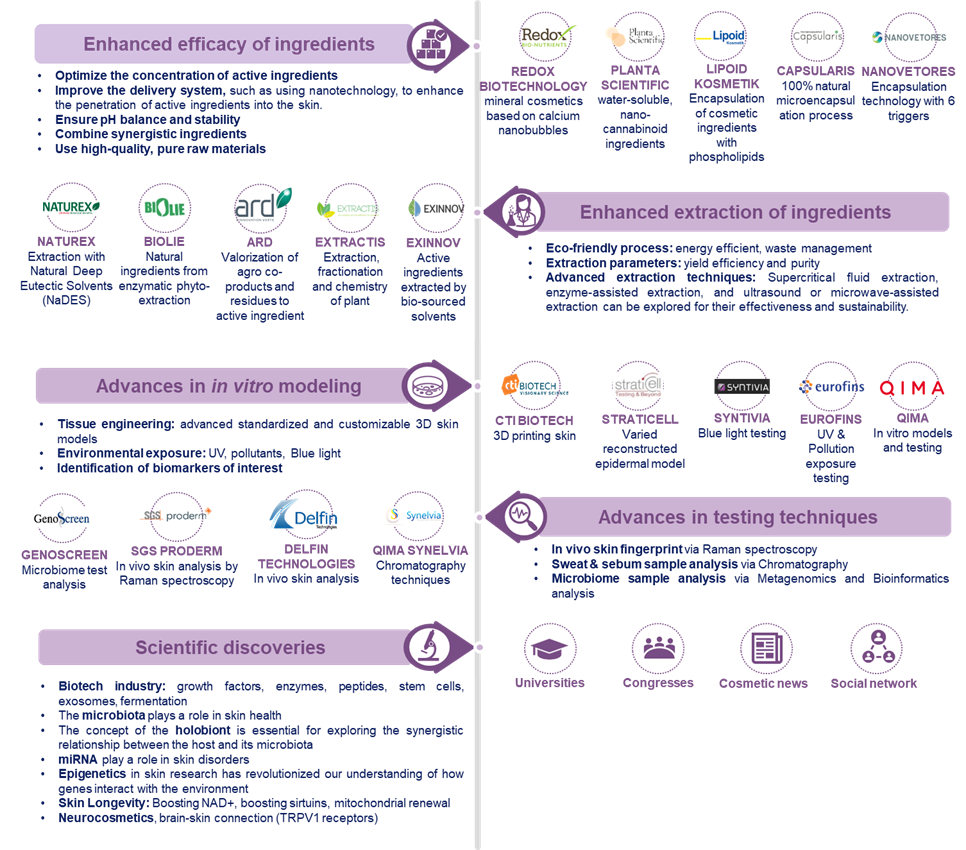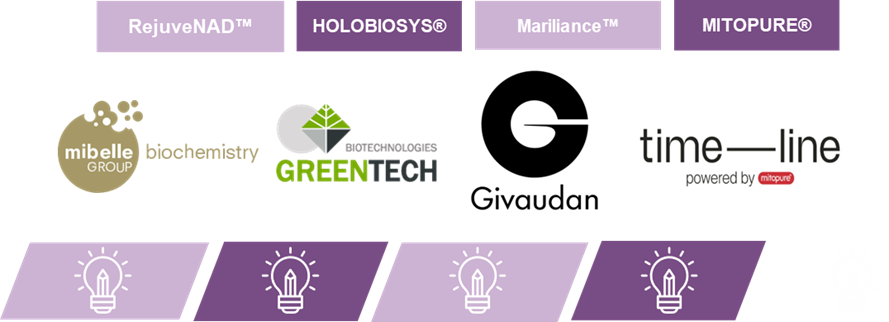STRATEGY #3 SCIENCE DRIVEN INNOVATION
The cosmetic industry is dynamic and heavily influenced by scientific advancements. Even what appears to be minor enhancements can actually be significant scientific milestones. In Europe, the cosmetics and personal care sector employs approximately 28,800 professionals across various scientific fields such as physics, microbiology, biology, dermatology, dentistry, toxicology, rheology, analytical chemistry, and genetics. This integration of cutting-edge scientific research is increasingly becoming a core strategy for innovation. Consumers are not only looking for more sustainable and natural ingredients, they also want ingredients backed by science with proven efficacy. The biotech industry has recently brought in new ingredients, including growth factors, enzymes, peptides, and stem cells, among others. Active ingredients became the focus of attention for scientific research. Furthermore, skincare is the fastest growing segment in the Beauty market by application, followed by haircare. However, optimized extraction and purification are required to yield these promising molecules, as well as a formulation step to increase their penetration into the skin. In the subsequent article, we will explore scientific domains ripe for innovation.
- Enhanced extraction of ingredients
In the cosmetic industry, the extraction of bioactive ingredients is a crucial process, and there are several innovative methods that have been developed to enhance this process. These methods aim to improve the efficiency, yield, and purity of the extracted compounds while also being environmentally friendly. Here are some of the key innovative extraction techniques.
Supercritical Fluid Extraction (SFE): This method uses supercritical fluids, most commonly carbon dioxide, as the solvent without leaving harmful residues.
Ultrasound-Assisted Extraction (UAE): UAE uses ultrasonic waves to create cavitation bubbles in the solvent, which helps to break down cell walls in the plant material and release bioactive compounds. This method is known for its rapid extraction rate and reduced solvent consumption.
Microwave-Assisted Extraction (MAE): MAE utilizes microwave energy to heat the solvent and plant material, which enhances the extraction process.
Enzyme-Assisted Extraction (EAE): In this method, specific enzymes are used to break down cell walls and facilitate the release of bioactive ingredients.
Pressurized Liquid Extraction (PLE): Also known as accelerated solvent extraction, PLE uses high pressure to increase the solvent’s penetration and solubilization power, leading to more efficient extraction.
Ionic Liquids-Based Extraction: Ionic liquids are solvents that are liquid at room temperature and have unique solubilizing properties.
Phytonic Extraction: This green extraction technique uses non-toxic solvents like d-limonene (derived from citrus peels) and is particularly valued for its sustainability and safety profile.
Subcritical Water Extraction: Here, water under subcritical conditions (below its critical point) is used as a solvent. This method is environmentally friendly and effective for extracting thermolabile compounds.
Solid Phase Microextraction (SPME): A solvent-free extraction technique that involves using a fiber coated with a liquid or solid stationary phase, which absorbs the bioactive compounds.
Electro-assisted Extraction: This technique applies electrical currents to enhance the permeability of cell membranes, facilitating the release of bioactive compounds.
- Actors
- NATUREX, a French company, uses an extraction technology by eutectigenesis which captures the most valuable secondary metabolites of each plant. “Eutectys™ which consists of six high-definition active ingredients using NaDES (Natural Deep Eutectic Solvents), offers an alternative to conventional solvents and makes it possible to obtain biomimetic extracts with unique phytochemical profiles and increased performance.” ORTESA is their joint research lab mastering an expertise in eco-extraction.
- BIOLIE, a French company that creates enzymatic mixtures adapted to plants in their extraction process to obtain original natural ingredients from different types of raw materials: plants, algae, mushrooms, etc.
- ARD, a French expert in chemical extraction of plant proteins and proactive in the valorization of co-products. “ARD works mainly on field crops (sugar beet, wheat, barley or even alfalfa), dedicated crops (miscanthus, poplar, etc.), industrial agro-co-products (wheat and corn bran, beet pulp, alfalfa marc, etc.) and harvest residues (cereal straw). Depending on the processes used and the plant, the products obtained (alfalfa proteins, rare sugars, cosmetic active ingredients, food prototypes, etc.) can be used in a wide variety of sectors.”
- EXTRACTIS is a French Agro-Industrial Technical Institute specializing in the field of extraction, fractionation and chemistry of plant biomass for the development of innovative products/processes.
- EXINNOV, a French company localized in the West of France, performs the extraction of active molecules with subcritical water mainly for the field of nutraceuticals and using biosourced solvents in order to obtain purified molecules, mainly for the fields of cosmetics and nutraceuticals. A hydrogenator completes the production tool for the manufacture of vegetable butters, hydrogenated oils and solid cosmetics.
- ANTOFENOL, a company localized in Brittany, uses a microwave eco-extraction process allowing production on an industrial scale, quickly and without chemical solvents. This unique and natural process makes it possible to develop effective, sustainable, environmentally and health- friendly solutions for the agricultural, cosmetic and food sectors. Applicable to all types of plants, the technology combines 3 eco-extraction techniques: microwaves, vacuum and mixing, within a single piece of equipment.
- Enhanced efficacy of ingredients
Formulation science plays a pivotal role in driving innovation within the cosmetic industry, leveraging advanced technologies and ingredients to meet the ever-evolving demands of consumers for safer, more effective, and sensorially pleasing products.
The incorporation of nanotechnology and sophisticated delivery systems allows for the precise targeting and controlled release of active ingredients, enhancing their efficacy and penetration into the skin. These nanocarriers can also improve the stability and shelf-life of products by protecting sensitive components from degradation. For example, startups are using micellar nanoparticle technology to produce more effective cleaners. Various types of other nanomaterials, such as nanosomes, liposomes, fullerenes, and solid lipid nanoparticles, are also used in the manufacture of cosmetics. These provide a long-lasting effect, enhanced color, and finish quality to cosmetics.
Additionally, the thoughtful selection and optimization of preservatives are crucial not only for ensuring the safety and longevity of cosmetic formulations but also for maintaining the integrity of natural and sensitive ingredients. Moreover, the science of formulation is essential in developing products with desirable textures and sensorial qualities, which are key factors in consumer satisfaction and product differentiation. By manipulating the rheology and physical properties of formulations, scientists can create innovative textures that provide unique tactile experiences, from silky serums to luxurious creams. Finally, the stability of these formulations, both physically and chemically, is paramount to ensure that the product remains effective and pleasant to use over time. Through the lens of formulation science, the cosmetic industry continues to advance, bringing sophisticated, high-quality products to market that cater to the specific needs and preferences of consumers worldwide.
- Actors
L’Oreal, Procter & Gamble, Henkel, Unilever and Kao Corp are the five corporations with the most nanotechnology patents. L’Oreal is the leader among companies with the highest number of nanotechnology patents in cosmetic products.
Redox Biotechnology, a South Korean start-up creating mineral cosmetics based on calcium nanobubbles. The startup creates cosmetics that moisturize the skin, eliminate bacteria, improve the elimination of toxins, and improve the skin’s metabolism and healing.
Planta Scientific, an American start-up creating nanocannabinoid ingredients with high bioavailability for the cosmetics industry. The start-up’s nanomolecules are small enough to reach receptors at the cellular level, making it more active and bioavailable than regular cannabidiol (CBD). The solution allows brands to create CBD-infused cosmetics and personal care products.
Lipoid Kosmetik, a Swiss company that offers offer both pre-loaded systems with well-known active ingredients as well as empty carriers for modular encapsulation. For hydrophilic actives, the LIPOID liposome range (pre-loaded carrier) or the Natipide® range (empty carrier) and lipophilic actives, the PhytoSolve® technology (pre-loaded carrier) or the PHOSAL® range (empty carrier). Finally, for a combination of hydrophilic and lipophilic actives, they recommend using Ultraspheres®.
Capsularis, a Breton company that has developed an exclusive microencapsulation process. This cutting-edge technology makes it possible to coat a very wide range of active substances with a 100% natural protective layer. “The active substance, liquid or solid, is encapsulated with a protective layer, composed of fatty material of plant origin, the melting point of which depends on the manufacturing process of the product. The active substance is released when the melting point is reached or by enzymatic action.
Nanovetores, a Brazilian company, with an encapsulation technology allowing a prolonged release of active ingredients through 6 innovative and specific triggers: water, pH, temperature, enzymatic, friction and light.
- Advances in in vitro efficacy testing
Advances in in vitro efficacy testing are revolutionizing the cosmetic industry, providing a critical foundation for innovation and product development. These cutting-edge techniques enable researchers to accurately evaluate the safety and effectiveness of new ingredients and formulations without the ethical and logistical complexities of animal testing. By simulating human skin or hair conditions in a controlled environment, in vitro methods offer precise insights into how a product performs in terms of absorption, irritation potential, and efficacy in delivering active ingredients. This not only accelerates the development of innovative products but also enhances consumer trust by ensuring that the cosmetics are both safe and effective.
There are more and more progress in tissue engineering to generate standardized 3D skin models that closely mimic real human skin, diverse range of skin types and skin disorders. Skin models become more and more sophisticated by adding nerves, melanocytes, fibroblast matrix, immune cells, vascularization with technologies such as organ on chips, 3D printed skin.
Advancements in in vitro efficacy testing enable the simulation of environmental exposures that impact skin health. By utilizing technologies such as UV simulators, pollution exposure boxes, and blue light simulators, researchers can mimic the exact conditions our skin faces daily, from the sun’s harsh rays to the pollutants in urban air and the blue light emitted by screens. This controlled exposure allows for the precise measurement of a product’s ability to protect against these elements, including defense mechanisms against airborne pollution like ozone, cigarette smoke, and particulate matter, as well as offering blue light protection. These innovative testing methods not only enhance our understanding of the exposome—the totality of exposures our body faces—but also drive the development of protective formulations against environmental aggressors.
Finally, the choice of the in vitro biomarkers to be analyzed will be carefully correlated with clinical studies to link what is occurring at the cellular level to the beneficial effects observed on panelists in vivo.
- Actors
- StratiCELL: offers various types of in-house 3D reconstructed epidermis according to the efficacy test.
- CTIBiotech: In collaboration with BASF, CTIBiotech has developed the first 3D bioprinted human reconstructed skin including immune macrophages.
- Labskin Creations: In collaboration with Chanel, Labskin creation, a French bio-technology start-up specializing in advanced 3D engineering of skin and fat tissue, has introduced its latest innovation: 3D bioprinting of reconstructed human skin with a pigment spot in the middle. The goal of this project is to better assess the mechanism of these imperfections to produce more effective skin care products.
- SYNTIVIA, a French company, has developed a blue light irradiation dose corresponding to 1h to 2h40 of screen exposure. It allows us to test and validate cosmetic product’s efficacy against blue light-induced skin damages.
- Bio-EC (Eurofins), a French company, has developed an exclusive process of exposure of explants to atmospheric pollutants called “Pollubox” which may contain the following pollutants: hydrocarbons, heavy metals, diesel particles, Ozone, Cigarette smoke etc… This device enables pollutants to be vaporized into cloud form and to be put into contact only with the surface of the skin to resemble physiological conditions as closely as possible.
- QIMA Life Science, a French company, is particularly dedicated to the development of in vitro methods as an alternative to animal testing, providing solutions for preclinical research, the development of drug candidates, active ingredients and cosmetic formulations.
- Neuron Experts, based in Marseille (France), is a Contract Research Organization (CRO) specialized in the study of neuro-active compounds. The company uses its own tests based on primary neuronal cell cultures modeling neurodegenerative diseases and neuronal impairment-induced skin disorders. As models, they use a co-culture of sensory neurons and skin keratinocytes or nerve-muscle co-culture. As endpoints, they perform sensory neuron endings analysis and free nerve endings quantification, analysis of specific receptors (TRPV1, TrkA …) in models with sensory neurons and measurement of neurotransmitters released by the sensory neurons (CGRP, substance P). They can also evaluate spontaneous contract ions of muscle fibers and a myorelaxant effect. In collaboration with StratiCELL, they have developed a unique model of cocultured reconstructed human epidermis and human sensory neurons « RHE-huSN » model, where human sensory neurons (derived from induced pluripotent stem cells (iPSC)) are growing in the immediate vicinity of 3D reconstructed human epidermis, i.e. on the backside of the polycarbonate support.
- NETSKINMODELS is a European Network for Skin Engineering and Modeling. “In the proposed COST Action NETSKINMODELS, interdisciplinary and intersectoral research and coordinated initiatives will drive the development and validation of standout sophisticated cell-based and computational skin models, including the development of artificial intelligence models for dermatological research. Furthermore, the Action has ambitions to develop ethical and sustainable reagents required for the elaboration of organotypic skin models, based on a strong partnership between network academia and industries.”
- Advanced testing techniques
Advanced testing techniques contribute to the development of personalized products that are effective and specifically adapted to individual skin types and conditions. For example, Raman spectroscopy provides a detailed “fingerprint” of skin in vivo, it reveals the composition of the skin. Chromatography is used to analyze sweat and sebum and evaluate the effect of cosmetic products. Metagenomics and bioinformatics analyze the skin’s microbiome, which provides an understanding of how cosmetics influence and interact with these microscopic communities.
- Actors
- SGS ProDerm, a German company, measures dermal water content with confocal Raman spectroscopy for proving anti-aging product effects. Confocal Raman spectroscopy is also suitable to assess hair cleansing-derived skin dryness on human scalp.
- HELLOBIOME is a B2B AI platform that utilizes microbiome data for personal care innovation, clinical research and personalization. For an even more personalized skincare test, consumers can order the microbiome test from Elsa Jungman.
- BIOFILM CONTROL, a French company expert in microbiota and biofilm, which characterizes and optimizes the effectiveness of products active on microorganisms in real conditions of use.
- Genoscreen, a French pioneering company in sequencing, genotyping and bioinformatics that offers innovative genomics services and solutions to meet the needs of academic and industrial research teams. For the Skin microbiota, GenoBiome Skin offers a comprehensive offering for the analysis of skin microorganism communities and “Microbiome friendly” test attesting to the safety of a product on skin flora.
- Delfin Technologies, located in Finland, Delfin Technologies is a world leader in portable skin research instruments offering innovative, scientifically validated portable instrumentation for measuring various skin properties and the effect of products to the skin. Delfin offers a wide range of instruments for measuring various skin parameters.
- Qima Life Science (formerly Synelvia), a French group, offers analytical chemistry services such as chromatography techniques to analyze specific skincare and haircare biomarkers.
- METAGENOPOLIS is the INRAE research unit of Excellence in Microbiome Analysis offers sample management & storage, quantitative metagenomics and functional metagenomics
- Scientific discoveries
Scientific discoveries are introducing new ingredients and concepts in cosmetics.
The biotech industry has brought in new ingredients, including growth factors, enzymes, peptides, and stem cells, among others. Among these innovations are whitening enzyme lightening products, such as those containing peroxidase and laccase, which offer a more natural approach to achieving brighter, more even-toned skin. Fermented ingredients are also gaining popularity, celebrated for their enhanced bioavailability and potent antioxidant properties, making them highly effective in skincare regimens. Additionally, plant stem cells are being explored as a rich source of ingredients, offering unparalleled anti-aging and regenerative benefits. The concept of white biotech, which focuses on using biotechnology for industrial purposes, including fermentation processes, is instrumental in producing these ingredients sustainably.
The human microbiome is the set of microorganisms that live on and in our bodies, including the skin. Recent research has shown that the microbiome plays a crucial role in maintaining skin health, and that an imbalance in the microbiome can lead to various skin problems. As a result, there is a growing interest in creating skincare products that respect the microbiome and can help support its health and function. This is often done by using prebiotics and probiotics in skin care products, which can help nourish and support the growth of beneficial microorganisms. Incorporating probiotics (live beneficial bacteria) and prebiotics (nutrients that feed these bacteria) into cosmetic products can help maintain or restore the balance of the skin’s microbiome. Examples of prebiotics and probiotics commonly used in skin care products include lactobacilli and bifidobacteria. These ingredients can help improve skin hydration, reduce inflammation, and improve skin barrier function.
The concept of the holobiont, which refers to the host along with its symbiotic microorganisms functioning as a single ecological unit, has emerged as a revolutionary idea in the cosmetic industry. This paradigm shift towards viewing the skin not just as an organ but as an ecosystem of human cells intermingled with a diverse array of microorganisms (including bacteria, fungi, and viruses) opens new avenues for product development. The adoption of the holobiont concept signifies a move towards more holistic, science-based solutions in skincare, promising more personalized and effective treatments that align with the body’s natural processes.
MicroRNAs, small non-coding RNA molecules playing a crucial role in regulating gene expression, have been found to be involved in various skin-related processes. The study of miRNAs in skin health is a relatively new field, offering innovative pathways for research and development in dermocosmetics. Companies investing in this research could potentially develop groundbreaking products based on cutting-edge science. MicroRNAs (miRNAs) are emerging as potential markers in the field of dermocosmetics for several compelling reasons. Although there are more published research on dermatological treatments of skin disorders & would healing, there is a potential for cosmetic research to target specified miRNAs to improve skin health, using miRNA mimics and miRNA antagomiRs. Cosmeceutical potential of miRNA targeted technologies include skin whitening, skin barrier repair and aging prevention.
Epigenetics, the study of how behaviors and environment can cause changes that affect the way genes work, offers a profound understanding of how external factors such as pollution, diet, and UV exposure can influence gene expression without altering the DNA sequence itself. By targeting these epigenetic changes, cosmetic products can now be designed to not only counteract the visible signs of aging but also to activate the skin’s intrinsic repair processes, leading to genuine rejuvenation. This approach allows for the development of products that can effectively “reprogram” skin cells to behave more youthfully, enhancing their ability to regenerate, improve collagen production, and maintain hydration.
Skin longevity, a newly introduced concept, is an innovative approach that emphasizes the importance of long-term skin health and resilience. It is associated with a boost of NAD+ (standing for Nicotinamide adenine dinucleotide) levels or an elevation of sirtuins expression and mitochondrial renewal.
Neuro-cosmetics explore the brain-skin axis using markers like TRPV1 receptors. They are used to reduce symptoms of sensitive skin, bring a soothing effect and reduce stress.
The best way to track scientific discoveries is by attending scientific congresses, collaborate with research labs, keep an eye on the latest research articles and journals.
- Actors
- Biossance, a US company, uses fermented skincare ingredients. Their team of UC Berkeley scientists discovered how to engineer a plant-based version of squalene – called squalane – from fermenting sustainable sugarcane and yeast. In addition, they have a fermented lemon peel that provides antioxidant support to the skin, helping to improve the look of uneven skin tone and prevent signs of discoloration.
- Alganelle (SEQENS) is a Savoyard start-up in synthetic biology, a specialist in industrial fermentation aimed at the production of polypeptides, proteins, polysaccharides and various metabolites directly in bacteria, yeasts or microalgae modified by genetic and metabolic engineering. In 10 years, Alganelle has developed expertise at the cutting edge of synthetic biology, for sustainable development and the production of high-quality natural molecules from microalgae, used as photosynthetic cell factories.
These compounds (metabolites, polysaccharides, synthetic intermediates, proteins, etc.) are then used as ingredients by the biomedical, cosmetic and pharmaceutical industries. - Ginkgo BioWorks is a US biotech company which has genetically engineered yeast fermentation to produce rose oil with new and unique scents without relying on expensive rose petals.
- Arcaea, a US company, has developed ScentARC technology via high throughput screening and machine learning. It is a precise nutrient blend that impacts underarm microbes, shifting odor profile by selectively preventing the body’s production of odorous compounds.
- PAULA’s CHOICE, a Unilever brand that offers powerful content and digital tools to demystify the science behind skincare, including an exhaustive “Ingredient Dictionary” that breaks down the research behind nearly 4,000 ingredients, and Expert Advice, an online hub for knowledge about skin care and ingredients.
- GREENTECH HOLOBIOSYS® based its marketing on the holobiont concept with metaproteomics studies focusing on host/microbiota interactions. Holobiosys stimulates these anti-age and hydration functions in both the host and microbiota
- GIVAUDAN MARILIANCE™, a neurosoothing active that decreases the production of inflammation and neuro-inflammation mediators, slows down the expression of pain receptors at the surface of skin neurons and reduces significantly skin sensitivity.
- MIBELLE BIOCHEMISTRY REJUVENAD™ active based its marketing on Skin Longevity molecule NAD+ (nicotinamide adenine dinucleotide) due to difficulties to stabilize the molecule, they aim at boosting the corresponding enzyme NAMPT which leads to increase NAD+ levels in skin cells.
- Timeline, a Swiss biotech company recently acquired by LOREAL has developed a proprietary molecule, Mitopure®, containing Urolithin A postbiotic, that promotes mitochondrial renewal, the powerhouses of cells.
- SEDERMA SENESTEM™ is based on an extract of Plantago lanceolata, derived from plant cell culture technology. The active induces a decrease of miR-30e and miR-181a expressions to reduce the appearance of senescent phenotypes, a decrease of miR-29 and miR-196a expressions to boost extracellular matrix macromolecule synthesis and finally decreases miR-21 that controls MMPs
- BIOCOGENT – DermalRx® Acetygen® is based on a unique mixture of Agrimonia eupatoria and Ampelopsis grossedentata extracts and rejuvenates the extracellular matrix E.C.M. through broad-spectrum epigenetic modulation of gene expression.
- Gallinée, a French pioneer of the microbiome-friendly skincare wave. “At Gallinée we are the first to offer ‘microbiome-friendly’ oral care products” explains the brand’s founder, Marie Drago.
- Beiersdorf scientists have studied epigenetics & skin rejuvenation and developed an “age clock” specific to the skin with the patented SKIN AGE CLOCK technology which helps them find novel skin care solutions to make people look younger.
Sources:
Websites article :
- Innovation and Future Trends in the Cosmetic industry. Cosmetics Europe website. https://cosmeticseurope.eu/cosmetics-industry/innovation-and-future-trends-cosmetics-industry/
- Herich, D, The Benchmarking Company (2022, October 24th). What Consumers Want from Beauty in 2023. Global Cosmetic Industry Magazine. https://www.gcimagazine.com/consumers-markets/news/22512091/what-consumers-want-from-beauty-in-2023
- (2021, May 25th). 14 Trends Changing The Face Of The Beauty Industry In 2021. Website of CB INSIGTHS. https://www.cbinsights.com/research/report/beauty-trends-2021/
- Trends in the Cosmetics Industry US and Europe. Website of Snipp. https://www.snipp.com/cosmetics-industry-trends
- (2023, December 5th). Cosmetics Business predicts the top 5 beauty trends of 2024 in new report. Website of Cosmetic Business. https://cosmeticsbusiness.com/cosmetics-business-predicts-the-top-5-beauty-trends
- Doolan K. (2024, January 16th). “To recycle and rejuvenate mitochondria”: Longevity takes the spotlight with L’Oréal’s investment in Timeline. Website of Cosmetics Design Europe. https://www.cosmeticsdesign-europe.com/Article/2024/01/16/longevity-takes-the-spotlight-with-l-oreal-s-investment-in-timeline?utm_source=newsletter_daily&utm_medium=email&utm_campaign=17-Jan-2024&cid=DM1114085&bid=301307105
- Whitehouse L. (2016, December 15th). Anti-pollution claims: how to test them. Website of Cosmetics Design Europe. https://www.cosmeticsdesign-europe.com/Article/2016/12/15/Anti-pollution-claims-how-to-test-them
- Ourisman J. (2023, December 21st) These Will Be the Biggest Skin-Care Trends of 2024. Website of Allure. https://www.allure.com/story/biggest-skin-care-trends-2024
Review articles :
- Ustymenko, R. (2023). TRENDS AND INNOVATIONS IN COSMETIC MARKETING. Economics & Education, 8(3), 12-17. https://doi.org/10.30525/2500-946X/2023-3-2
- J. Pharm. Sci. Rev. Res., 68(1), May – June 2021; Article No. 30, Pages: 190-197. http://dx.doi.org/10.47583/ijpsrr.2021.v68i01.030








